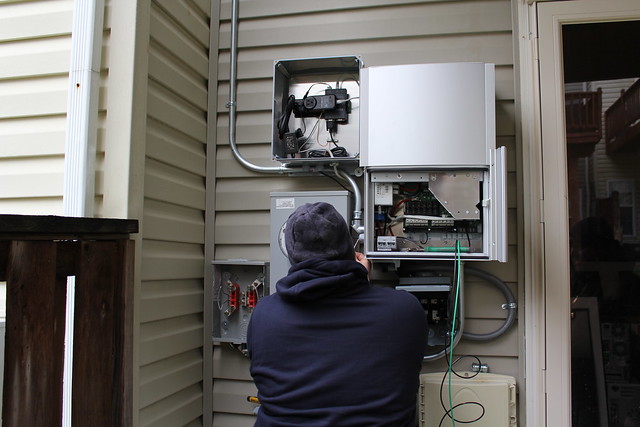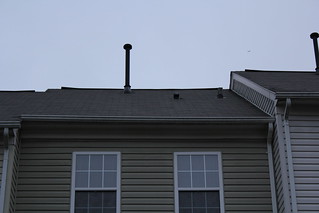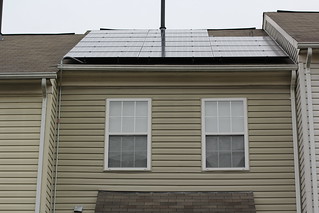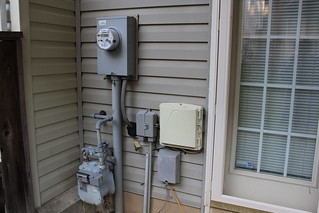Going Solar: Installation Day
This is part of an ongoing essay detailing my experiences with solar energy. To see if solar is right for you, visit SunPower.
The Install
A crew of four braved a cold and overcast day to install the system. They quickly split into two groups, the first focusing on the roof work and the other on the electrical work. Throughout the day they dealt with wind, lack of sunlight, and the post-rain muddy expanse that was my back yard.
Electrical
The electrical team mounted the inverter, production meter, monitoring panel, utility disconnect, and interconnecting conduit to the exterior of the house. They drilled through the wall into the rear of my electrical panel, feeding wire to attach to the backfeed breaker.
My panel was full, so they had to exchange two breakers for tandem breakers to make room for the PV backfeed breaker. With the exception of the affected breakers (servicing an appliance circuit and range hood), this work was done with the power on.
They bent and mounted conduit leading up to the roof, then pre-fed all the cabling up to connect it to the strings of panels.
In the process of mounting some of the equipment, I noticed my interior lights flickering. When I informed the electrician, he checked all of my breakers and mains for loose wires. Finding none, he started tapping the drywall around the panel, eventually finding a spot where if he knocked hard the power to the whole house would cut out (and knocking again would restore it). Suspecting the loose wire was in the meter (directly on the other side of the wall), he went outside and cracked the meter; one of the post-meter nuts was loose, the washer below visibly moving around and not keeping good contact; the other nut was completely rusted. He was able to tighten the one temporarily and I phoned BGE to come to inspect the other. A BGE technician arrived in a few hours, looked with amusement at all this solar stuff ("two meters?" and "solar, huh?"), but nevertheless disconnected all the mains and replaced most of the components behind the meter.
The inverter talks to SunPower (the company) for monitoring purposes, so a small monitoring device needed to the plugged into my router via Ethernet cable.
The last part was initializing the system, but by the time the panels were installed we had run out of light and the inverter wouldn't be able to register whether the panels were functioning. The team would return the following morning to complete this step.
Roof
The roof team measured things out, then navigated my attic's tiny entrance and drifts of blow-in insulation to install reinforcing lumber to the top chords. In concert with the guy in the attic, another guy got anchored to the roof and got to work installing the rail system that the panels would be mounted to.
Mounting solar panels is one of those processes where the majority of the work is in the prep, where nothing big appears to be happening for hours. Once all that work is complete, the act of hauling the panels up and attaching them occurs very quickly.
In the Maryland winter, it gets dark around 4:30pm. Due to the height and pitch of the roof, it took longer than expected, and we ran out of daylight. The crew had to return the following morning to finish mounting and connecting the last few panels.
The Aftermath
The roof, before and after the install:
And the exterior utilities, before and after the install:
I also took time-lapse video of the day, which turns the nine hour install into four minutes and shows how most of the work is in the prep.
Next: Activation
Last Modified: 2016-04-27
§
Home | All Entries | Search | Errata
Copyright © 2014-2024 Alex Moundalexis, licensed under a Creative Commons License. Some rights reserved.




